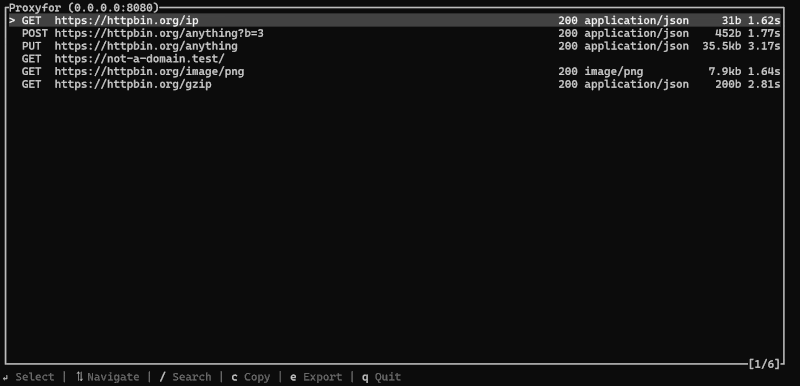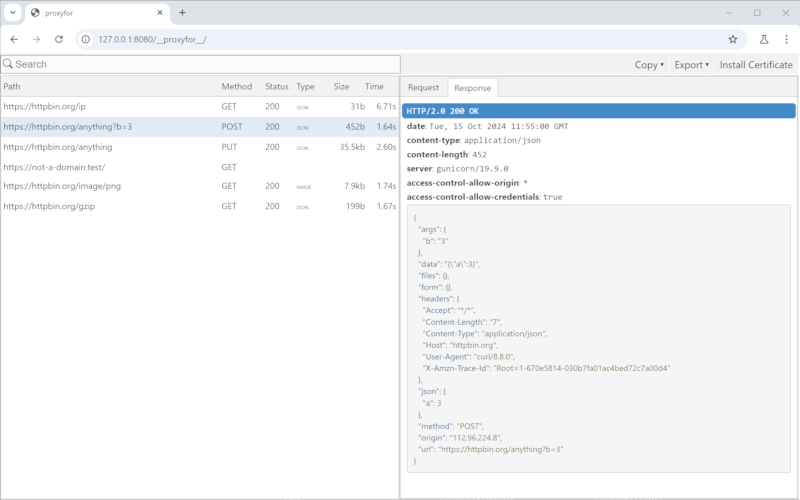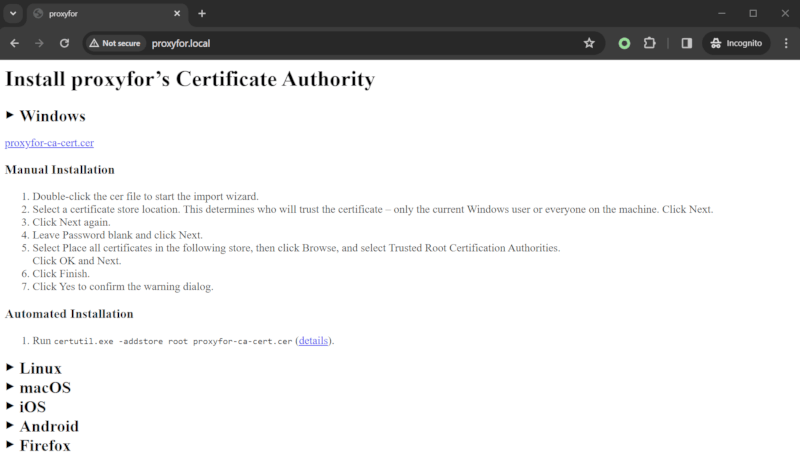5 releases (breaking)
| 0.5.0 | Dec 24, 2024 |
|---|---|
| 0.4.0 | Oct 15, 2024 |
| 0.3.0 | Apr 2, 2024 |
| 0.2.0 | Mar 7, 2024 |
| 0.1.0 | Mar 6, 2024 |
#529 in WebSocket
320 downloads per month
195KB
3.5K
SLoC
Proxyfor
A powerful and flexible proxy CLI for capturing and inspecting HTTP(S) and WS(S) traffic.
Key Features
- Forward & Reverse Proxy: Supports both forward proxy (client explicitly uses the proxy) and reverse proxy (proxy sits in front of the server).
- Multi-Protocol Support: Handles HTTP, HTTPS, WebSocket (WS), and secure WebSocket (WSS) protocols.
- Flexible Filtering: Filter traffic based on method, URI, and content-type for targeted analysis.
- Multiple Interfaces: Includes a user-friendly Terminal User Interface (TUI) and a web-based interface (WebUI) for inspecting captured data.
- CA Certificate Management: Simplifies the process of installing the necessary CA certificates to decrypt HTTPS traffic.
- Export Options: Export captured traffic in various formats, including Markdown, cURL commands, and HAR files.
- Non-Blocking Streaming: Captures request/response data in a non-blocking, streaming fashion for efficient handling of large volumes of traffic.
- Cross-Platform & Standalone: Delivered as a single, self-contained executable for Windows, macOS, and Linux, simplifying setup and distribution.
Screenshots
Terminal User Interface (TUI)
Web User Interface (WebUI)
Installation
With cargo
cargo install proxyfor
With docker
docker run -v ~/.proxyfor:/.proxyfor -p 8080:8080 --rm sigoden/proxyfor --web
Binaries on macOS, Linux, Windows
Download from Github Releases, unzip and add proxyfor to your $PATH.
Proxy Modes Explained
Forward Proxy
In this mode, your client applications (e.g., web browsers, curl) are configured to send their requests to proxyfor, which then forwards them to the target servers. You would configure your client to use a proxy at http://127.0.0.1:8080.
proxyfor
curl -x http://127.0.0.1:8080 httpbin.org/ip
Reverse Proxy
In reverse proxy mode, proxyfor sits in front of a target server. Clients access proxyfor and it forwards the requests to the defined URL. This mode is ideal when clients cannot be configured to use a proxy.
proxyfor https://httpbin.org
curl http://127.0.0.1:8080/ip
Command Line Interface (CLI)
Usage: proxyfor [OPTIONS] [URL]
Arguments:
[URL] Reverse proxy url
Options:
-l, --listen <ADDR> Listening ip and port address [default: 0.0.0.0:8080]
-f, --filters <REGEX> Only inspect http(s) traffic whose `{method} {uri}` matches the regex
-m, --mime-filters <VALUE> Only inspect http(s) traffic whose content-type matches the value
-W, --web Enable user-friendly web interface
-T, --tui Eenter TUI
-D, --dump Dump all traffics
-h, --help Print help
-V, --version Print version
Choosing User Interface
proxyfor provides several ways to interact with captured traffic:
proxyfor # Enter TUI, equal to `proxyfor --tui`
proxyfor --web # Serve WebUI
proxyfor --web --tui # Serve WebUI + Enter TUI
proxyfor --dump # Dump all traffics to console
proxyfor > proxyfor.md # Dump all traffics to markdown file
Specifying Address and Port
Customize the listening address and port:
proxyfor -l 8081
proxyfor -l 127.0.0.1
proxyfor -l 127.0.0.1:8081
Filtering Traffic
Apply regex filters to limit captured traffic based on method and URI:
proxyfor -f httpbin.org/ip -f httpbin.org/anything
proxyfor -f '/^(get|post) https:\/\/httpbin.org/'
Filter based on MIME types:
proxyfor -m application/json -m application/ld+json
proxyfor -m text/
CA Certificate Installation
To decrypt HTTPS traffic, you must install proxyfor's CA certificate on your device. The easiest way to do this is to use the built-in certificate installation app.
- Start
proxyforwith desired proxy settings. - On your target device, configure the device to use
proxyforas the proxy. - Open a web browser on the target device and navigate to proxyfor.local.
- Follow the on-screen instructions to download and install the CA certificate.
License
Copyright (c) 2024-∞ proxyfor-developers.
Proxyfor is made available under the terms of either the MIT License or the Apache License 2.0, at your option.
See the LICENSE-APACHE and LICENSE-MIT files for license details.
Dependencies
~48–83MB
~1.5M SLoC


